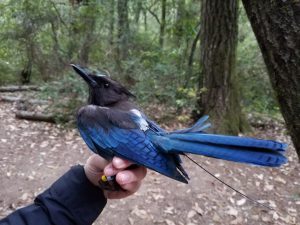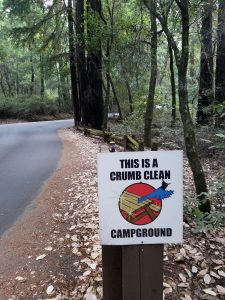Posted 12/17/18
In the old-growth redwoods of central California, a battle is playing out between two native species. Human activities encourage the proliferation of synanthropic species like the Steller’s Jay; simultaneously, humans have also contributed to the decline of habitat specialists like the Marbled Murrelet. Ph.D. student Kristin Brunk is conducting research to determine if Steller’s Jay management is effective in conserving the federally threatened Marbled Murrelet.

Ph.D. student Kristin Brunk works in the old-growth redwoods of central California to understand the efficacy of current management for Steller’s Jays (Cyanocitta stelleri) and the implications of this management for the federally threatened Marbled Murrelet (Brachyramphus marmoratus). Both are native bird species in the redwoods, but Steller’s Jays are a synanthropic species, meaning they benefit from associating with humans, while Marbled Murrelet populations have severely declined. As populations of Steller’s Jays have increased, they have threatened the viability of Marbled Murrelet populations mainly through nest predation. Nowhere has this threat been more dire than in protected campground areas in remnant patches of old-growth forest. These areas have Steller’s Jay populations that are twice as high as in non-human dominated forests, and these campground areas also represent 60% of all remaining Marbled Murrelet nesting habitat in central California.

Murrelet reproduction is naturally slow, as adults only produce one chick per year, but in central California where Steller’s Jay populations are subsidized by human foods, about 80% of Marbled Murrelet nests fail, due mostly to predation. Reducing corvid predation would help boost murrelet reproduction, which is believed to offer the highest probability of Marbled Murrelet population recovery in central California. In 2013, in an attempt to combat corvid predation, California State Parks implemented multiple non-lethal strategies to manage Steller’s Jays. These included improving trash management, deploying noxious murrelet mimic eggs to create taste aversion to murrelet eggs in corvids, and the “Crumb Clean” campaign, an effort to educate campers about the harm of feeding corvids and eliminate corvid access to camper food. The crumb clean campaign requires campers to properly store or dispose of all foodstuffs in their camp. Through the elimination of this food source in the campgrounds, the hope is that jay populations will decrease, allowing more murrelet nests to succeed. Brunk’s research focuses on comparing jay density, home range size, body condition, and diet between pre- and post-management jay populations to determine if these management strategies have been successful.

Brunk focuses her work within the campgrounds of Big Basin Redwoods State Park by capturing Steller’s Jays in mist nets. Once she has captured a jay, Brunk takes a tail feather sample to determine the bird’s body condition and a flight feather sample to determine what the bird has been eating. Body condition is determined by measuring feather growth bars, and Brunk deciphers how much human food the jays eat by performing stable isotope analyses on flight feather samples. Each jay is also banded with a unique color combination, so individuals can be identified without re-capturing them, and males are fitted with a backpack-mounted radio-transmitter. By tracking birds with radio-transmitters, Brunk is able to understand how jay home range sizes have changed since management started. Despite a perpetual battle of wits with the extremely intelligent Steller’s Jays, Brunk has successfully banded about 85% of the jays in her study area.
In addition to her research, Brunk is also incredibly active in education and outreach throughout her study area. She gives talks at Big Basin Campfire Programs to educate the public about Marbled Murrelets and Steller’s Jays. Brunk conducts banding demonstrations so campers can see exactly how she captures the jays, and they can often participate in the release of banded jays. And as she walks through the campgrounds tracking birds with radio-transmitters, she frequently answers campers’ questions about the giant metal antenna she is carrying. Brunk works hard to foster good relationships with the other users of her study area and is passionate about sharing her work to promote better public understanding of management initiatives such as the crumb clean campaign.

Brunk plans to complete one more field season in 2019, but her research is far from over. Brunk is also working to evaluate a Habitat Conservation Plan (HCP) and its effectiveness at conserving Marbled Murrelet habitat on private land. Habitat Conservation Plans are a commonly used management strategy, with over 1000 HCPs currently active, but the efficacy of these plans has not been well-tested. Brunk hopes to determine if HCPs are an effective management technique, using the Marbled Murrelet as a case study. Overall, Brunk’s research aims to understand the effectiveness of management strategies and conservation of federally threatened species. Ultimately, what she discovers will be used directly in adaptive management strategies that will be paramount in preventing the extinction of the Marbled Murrelet. Along the way, Brunk hopes to uncover strategies and techniques that will apply to the conservation of other species in the future.
Story by Sutheimer, Colleen
